The graph above shows a consistent decline in the water volume since before 1998. The remains of St. Thomas have been exposed since 2002 and we hiked into the valley to view the concrete bases of some major town buildings such as the school, ice cream parlor, and hotel. Here is the terrascope group returning from our hike into the lake bed. The current edge of Lake Mead is a few miles to the right of the picture:
Afterwards, we headed towards the Hoover Dam. The drive was a bit longer than I expected but it clearly showed the magnitude of Lake Mead! There was a great conversation in my van about lead in the environment as a tracer because of the percent composition of its four isotopes. My favorite parts of this trip were the intelligent side conversations that consisted of asking a lot a questions and learning about a variety of different earth science answers. There is so much out there to discover about our planet!
We stopped at an overlook near the edge of the receding waters of Lake Mead:
We finally arrived at the great Hoover Dam. The amount of concrete used in this endeavor was unimaginable. It could be used to make a sidewalk around the entire equator of the earth! The concrete would never have dried if it was just poured into this form, so the engineers put pipes in the concrete and pumped it full of cool water. Then, they filled the holes with concrete. But, the dam will still be cooling/chemically reacting for another 150 years.

The Hoover Dam generates hydroelectric power from the waters it retains. It produces about 4 billion kilowatt hours of energy per year and provides this energy to a significant amount of Arizona, Nevada, and California. Here is a picture looking from the top of the dam out to the "after" side. The incredible dam bypass bridge is another concrete engineering wonder and is simply one of a kind. After being deterred by wind, the bridge now rises 890 feet above the Colorado River after its recent completion.

We went inside the dam and saw the 17 generators that were turned by the water. The lights on top of each one indicate whether it is on or not.
Here is a picture of Lake Mead from the top of the dam. The white "bathtub rings" indicate water level. At the highest point, the water would have reached the top of the rings. Since the bleached band is so thick, its clear that the area is in a drought and the struggle for water in the desert will continue to increase.

I also got a few of my favorite images from the trip at Zion National Park yesterday. Here are some sandstone rocks formed from sand dunes and the process of crossbedding and changing wind patterns overtime.
Here are some clouds rolling in:

































































